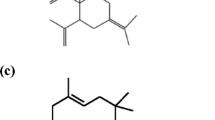Abstract
Detoxifying enzyme inhibitors are being used in insecticide formulations to restore insect susceptibility. Essential oils, also known as biopesticides, are volatile plant secondary metabolites. This study aimed to determine the potential of two essential oil constituents (thymol and (R)-(+)-pulegone) to act against the detoxifying enzymes of Spodoptera litura. Thymol and (R)-(+)-pulegone were studied on the third instar larvae of S. litura by topical application under laboratory conditions. Thymol and (R)-(+)-pulegone were found to be highly toxic to S. litura (24 h LC50 values of ~5.61 and 8.35 μg/larva, respectively) and significantly decreased the activity of carboxylesterases and cytochromes P450. Moreover, thymol (1.79 and 3.51 μg/larva) and (R)-(+)-pulegone (2.56 and 5.15 μg/larva) had a significantly higher inhibitory effect on carboxylesterase activity than the commercial inhibitor triphenyl phosphate (16 μg/larva). The results indicated that thymol and (R)-(+)-pulegone have the potential to be used as alternative inhibitors to develop insecticide formulations for controlling the agricultural insect pest S. litura.

Similar content being viewed by others
References
Alagawany, M., Farag, M. R., Abdelnour, S. A., & Elnesr, S. S. (2020). A review on the beneficial effect of thymol on health and production of fish. Reviews in Aquaculture, 13, 632–641.
Álvarez-Martínez, F. J., Barrajón-Catalán, E., Herranz-López, M., & Micol, V. (2021). Antibacterial plant compounds, extracts and essential oils: An updated review on their effects and putative mechanisms of action. Phytomedicine, 90, 153626.
Armes, N., Wightman, J., Jadhav, D., & Rao, G. (1997). Status of insecticide resistance in Spodoptera litura in Andhra Pradesh, India. Pesticide Science, 50, 240–248.
Avery, M. L., Decker, D. G., Humphrey, J. S., & Laukert, C. C. (1996). Mint plant derivatives as blackbird feeding deterrents. Crop Protection, 15, 461–464.
Bernard, C. B., & Philogène, B. J. R. (1993). Insecticide synergists: Role, importance, and perspectives. Journal of Toxicology and Environmental Health, 38(2), 199–223.
Bradford, M. M. (1976). A rapid and sensitive method for the quantitation of microgram quantities of protein utilizing the principle of protein-dye binding. Analytical Biochemistry, 72, 248–254.
Chang, L. L., & Hodgson, E. (1975). Biochemistry of detoxification in insects: microsomal mixed-function oxidase activity in the housefly, Musca domestica. Insect Biochemistry, 5, 93–103.
Chatuphonprasert, W., & Jarukamjorn, K. (2021). Effect of styrene oxide and diethyl maleate on expression of cytochrome P450 family 1 and glutathione store in mouse liver. Tropical Journal of Pharmaceutical Research, 20, 231–237.
Denholm, I., & Rowland, M. W. (1992). Tactics for managing pesticide resistance in arthropods: Theory and practice. Annual Review of Entomology, 37, 91–112.
Everson, J. L., Sun, M. R., Fink, D. M., Heyne, G. W., Melberg, C. G., Nelson, K. F., Doroodchi, P., Colopy, L. J., Ulschmid, C. M., Martin, A. A., McLaughlin, M. T., & Lipinski, R. J. (2019). Developmental toxicity assessment of piperonyl butoxide exposure targeting sonic hedgehog signaling and forebrain and face morphogenesis in the mouse: An in vitro and in vivo study. Environmental Health Perspectives, 127, 107006.
Feyereisen, R. (2015). Insect P450 inhibitors and insecticides: Challenges and opportunities. Pest Management Science, 71, 793–800.
Fujioka, K., & Casida, J. E. (2007). Glutathione S-transferase conjugation of organophosphorus pesticides yields S-phospho-, S-aryl-, and S-alkylglutathione derivatives. Chemical Research in Toxicology, 20, 1211–1217.
Gaire, S., Zheng, W., Scharf, M. E., & Gondhalekar, A. D. (2021). Plant essential oil constituents enhance deltamethrin toxicity in a resistant population of bed bugs (Cimex lectularius L.) by inhibiting cytochrome P450 enzymes. Pesticide Biochemistry and Physiology, 175, 104829.
Gunning, R. V., Devonshire, A. L., & Moores, G. D. (1995). Metabolism of esfenvalerate by pyrethroid-susceptible and resistant Australian Helicoverpa armigera (Lepidoptera: Noctuidae). Pesticide Biochemistry and Physiology, 51, 205–213.
Hilliou, F., Chertemps, T., Maïbèche, M., & Le Goff, G. (2021). Resistance in the genus Spodoptera: Key insect detoxification genes. Insects, 12, 544.
Hong, X., Chen, R., Hou, R., Yuan, L., & Zha, J. (2018). Triphenyl phosphate (TPHP)-induced neurotoxicity in adult male Chinese rare minnows (Gobiocypris rarus). Environmental Science & Technology, 52, 11895–11903.
Huang, S., & Han, Z. (2007). Mechanisms for multiple resistances in field populations of common cutworm, Spodoptera litura (Fabricius) in China. Pesticide Biochemistry and Physiology, 87, 14–22.
Huang, Q., Wang, X., Yao, X., Gong, C., & Shen, L. (2019). Effects of bistrifluron resistance on the biological traits of Spodoptera litura (Fab.) (Noctuidae: Lepidoptera). Ecotoxicology, 28, 323–332.
Hummelbrunner, L. A., & Isman, M. B. (2001). Acute, sublethal, antifeedant, and synergistic effects of monoterpenoid essential oil compounds on the tobacco cutworm, Spodoptera litura (Lep., Noctuidae). Journal of Agricultural and Food Chemistry, 49, 715–720.
Isman, M. B. (2000). Plant essential oils for pest and disease management. Crop Protection, 19, 603–608.
Isman, M. B. (2020). Commercial development of plant essential oils and their constituents as active ingredients in bioinsecticides. Phytochemistry Reviews, 19, 235–241.
Junhirun, P., Pluempanupat, W., Yooboon, T., Ruttanaphan, T., Koul, O., & Bullangpoti, V. (2018). The study of isolated alkane compounds and crude extracts from Sphagneticola trilobata (Asterales: Asteraceae) as a candidate botanical insecticide for lepidopteran larvae. Journal of Economic Entomology, 111, 2699–2705.
Kaur, V., Kaur, R., & Bhardwaj, U. (2021). A review on dill essential oil and its chief compounds as natural biocide. Flavour and Fragrance Journal, 36, 412–431.
Koul, O., Singh, R., Kaur, B., & Kanda, D. (2013). Comparative study on the behavioral response and acute toxicity of some essential oil compounds and their binary mixtures to larvae of Helicoverpa armigera, Spodoptera litura and Chilo partellus. Industrial Crops and Products, 49, 428–436.
Marsin, A. M., Muhamad, I. I., Anis, S. N. S., Lazim, N. A. M., Ching, L. W., & Dolhaji, N. H. (2020). Essential oils as insect repellent agents in food packaging: A review. European Food Research and Technology, 246, 1519–1532.
Narayanan, M., Ranganathan, M., Subramanian, S. M., Kumarasamy, S., & Kandasamy, S. (2020). Toxicity of cypermethrin and enzyme inhibitor synergists in red hairy caterpillar Amsacta albistriga (Lepidoptera: Arctiidae). The Journal of Basic and Applied Zoology, 81, 45.
Nobsathian, S., Ruttanaphan, T., & Bullangpoti, V. (2019). Insecticidal effects of triterpene glycosides extracted from Holothuria atra (Echinodermata: Holothuroidea) against Spodoptera litura (Lepidoptera: Noctuidae). Journal of Economic Entomology, 112, 1683–1687.
Norris, E. J., Johnson, J. B., Gross, A. D., Bartholomay, L. C., & Coats, J. R. (2018). Plant essential oils enhance diverse pyrethroids against multiple strains of mosquitoes and inhibit detoxification enzyme processes. Insects, 9, 132.
O'Neal, S. T., Johnson, E. J., Rault, L. C., & Anderson, T. D. (2019). Vapor delivery of plant essential oils alters pyrethroid efficacy and detoxification enzyme activity in mosquitoes. Pesticide Biochemistry and Physiology, 157, 88–98.
Plapp Jr., F. W., Bigley, W. S., Chapmen, G. A., & Eddy, G. W. (1963). Synergism of malathion against resistant house flies and mosquitoes. Journal of Economic Entomology, 56, 643–649.
Rehan, A., & Freed, S. (2014). Selection, mechanism, cross resistance and stability of spinosad resistance in Spodoptera litura (Fabricius) (Lepidoptera: Noctuidae). Crop Protection, 56, 10–15.
Ruttanaphan, T., Pluempanupat, W., & Bullangpoti, V. (2018). Cypermethrin resistance in Spodoptera litura (Fabricius) (Lepidoptera: Noctuidae) from three locations in Thailand and detoxification enzyme activities. Agriculture and Natural Resources, 52, 484–488.
Ruttanaphan, T., Pluempanupat, W., Aungsirisawat, C., Boonyarit, P., Goff, G. L., & Bullangpoti, V. (2019). Effect of plant essential oils and their major constituents on cypermethrin tolerance associated detoxification enzyme activities in Spodoptera litura (Lepidoptera: Noctuidae). Journal of Economic Entomology, 112, 2167–2176.
Salehi, B., Mishra, A. P., Shukla, I., Sharifi-Rad, M., Contreras, M. D. M., Segura-Carretero, A., & Sharifi-Rad, J. (2018). Thymol, thyme, and other plant sources: Health and potential uses. Phytotherapy Research, 32, 1688–1706.
Sanchez-Arroyo, H., Koehler, P. G., & Valles, S. M. (2001). Effects of the synergists piperonyl butoxide and S,S,S-tributyl phosphorotrithioate on propoxur pharmacokinetics in Blattella germanica (Blattodea: Blattellidae). Journal of Economic Entomology, 94, 1209–1216.
Shen, J., Li, Z., Li, D., Wang, R., Zhang, S., You, H., & Li, J. (2020). Biochemical mechanisms, cross-resistance and stability of resistance to metaflumizone in Plutella xylostella. Insects, 11, 311.
Shi, L., Shi, Y., Liu, M. F., Zhang, Y., & Liao, X. L. (2021). Transcription factor CncC potentially regulates the expression of multiple detoxification genes that mediate indoxacarb resistance in Spodoptera litura. Insect Science, 28, 1426–1438.
Snoeck, S., Greenhalgh, R., Tirry, L., Clark, R. M., Van Leeuwen, T., & Dermauw, W. (2017). The effect of insecticide synergist treatment on genome-wide gene expression in a polyphagous pest. Scientific Reports, 7, 13440.
Sönmez, A., Bilen, S., Albayrak, M., Yilmaz, S., Biswas, G., Hisar, O., & Yanik, P. D. T. (2015). Effects of dietary supplementation of herbal oils containing 1,8-cineole, carvacrol or pulegone on growth performance, survival, fatty acid composition, and liver and kidney histology of rainbow trout (Oncorhynchus mykiss) fingerlings. Turkish Journal of Fisheries and Aquatic Sciences, 15, 813–819.
Sun, Y.-P., & Johnson, E. R. (1972). Quasi-synergism and penetration of insecticides. Journal of Economic Entomology, 65, 349–353.
Tak, J.-H., & Isman, M. B. (2017a). Enhanced cuticular penetration as the mechanism of synergy for the major constituents of thyme essential oil in the cabbage looper, Trichoplusia ni. Industrial Crops and Products, 101, 29–35.
Tak, J.-H., & Isman, M. B. (2017b). Penetration-enhancement underlies synergy of plant essential oil terpenoids as insecticides in the cabbage looper, Trichoplusia ni. Scientific Reports, 7, 42432.
Tangtrakulwanich, K., & Reddy, G. V. P. (2014). Development of insect resistance to plant biopesticides: An overview. In D. Singh (Eds.), Advances in Plant Biopesticides (pp. 47–62). Springer. https://doi.org/10.1007/978-81-322-2006-0_4
Tavares, L., Santos, L., & Zapata Noreña, C. P. (2021). Bioactive compounds of garlic: A comprehensive review of encapsulation technologies, characterization of the encapsulated garlic compounds and their industrial applicability. Trends in Food Science & Technology, 114, 232–244.
Tharamak, S., Yooboon, T., Pengsook, A., Ratwatthananon, A., Kumrungsee, N., Bullangpoti, V., & Pluempanupat, W. (2020). Synthesis of thymyl esters and their insecticidal activity against Spodoptera litura (Lepidoptera: Noctuidae). Pest Management Science, 76, 928–935.
Wani, A. R., Yadav, K., Khursheed, A., & Rather, M. A. (2021). An updated and comprehensive review of the antiviral potential of essential oils and their chemical constituents with special focus on their mechanism of action against various influenza and coronaviruses. Microbial Pathogenesis, 152, 104620.
Xia, X., Lan, B., Tao, X., Lin, J., & You, M. (2020). Characterization of Spodoptera litura gut bacteria and their role in feeding and growth of the host. Frontiers in Microbiology, 11, 1492.
Acknowledgements
This research was supported by Walailak University (Grant No. WU64231). The authors would like to thank the Department of Zoology, Faculty of Science, Kasetsart University for facilitating experiment equipment and also thanks to ISB fund from Faculty of Science, Kasetsart University.
Author information
Authors and Affiliations
Contributions
T.R. and V.B. designed the experiments, conducted the experiments, analyzed the data, and wrote the manuscript. All the authors have read and approved the final version of the manuscript.
Corresponding author
Ethics declarations
Conflict of interest
The authors report no conflict of interest.
Additional information
Publisher’s note
Springer Nature remains neutral with regard to jurisdictional claims in published maps and institutional affiliations.
Rights and permissions
About this article
Cite this article
Ruttanaphan, T., Bullangpoti, V. The potential use of thymol and (R)-(+)-pulegone as detoxifying enzyme inhibitors against Spodoptera litura (Lepidoptera: Noctuidae). Phytoparasitica 50, 913–920 (2022). https://doi.org/10.1007/s12600-022-00989-1
Received:
Accepted:
Published:
Issue Date:
DOI: https://doi.org/10.1007/s12600-022-00989-1




